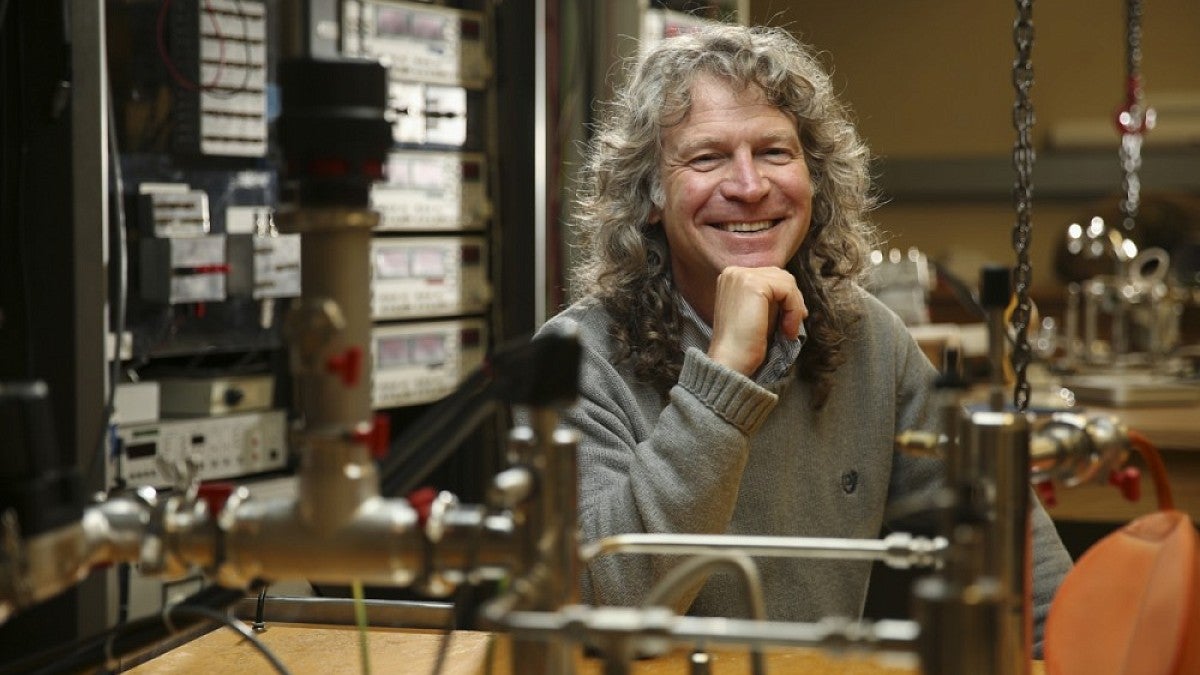University of Oregon physicist Richard Taylor is not the first scientist working on retinal implants, but by designing a bio-inspired device that interfaces directly with the body’s natural network of neurons, he and his research team are hoping to create a better implant.
That idea has new momentum, thanks to a new $900,000 grant from the Los Angeles-based W.M. Keck Foundation. The grant will fund Taylor’s work on a next-generation retinal implant, which is covered under a U.S. patent. The device could be used to reverse vision loss in those suffering from retinal diseases such as macular degeneration, a common eye condition and a leading cause of vision loss among people age 50 and older.
“This project has huge potential to have an enormous impact on society,” said Taylor, director of the UO Materials Science Institute. “The predictions are, that by 2050, as many as one in four people over the age of 50 could have macular degeneration.”
Existing implants make use of conventional electronics that are not well-suited to interface with neurons, Taylor said. His five-member, interdisciplinary team — which includes researchers in physics, chemistry, biology and neuroscience — is working on an implant that mirrors the structure of neurons related to the eyes and connects as seamlessly as possible.
Taylor’s area of research expertise centers on naturally occurring patterns known as fractals, which he calls the trademark building blocks of nature. He has studied fractals in physics, psychology, physiology, geography, architecture and art — including high-profile work identifying fractals in the paintings of Jackson Pollock that made national headlines. Increasingly, Taylor has focused on the development of electronics for biological systems.
“Neurons are fractal in shape. The dendritic branches of neurons repeat at multiple size scales,” Taylor said. “If we want electronics to interface with fractal neurons, we should really be thinking about making sure these electronics have the same fractal geometry.”
Taylor’s research group came together in 2013 with the support of a $50,000 innovation award designed to help jump start interdisciplinary research projects at the UO. The team includes Benjamin Aleman and Miriam Deutsch of the Department of Physics, Darren Johnson in the Department of Chemistry and Biochemistry and Cris Niell of the Department of Biology.
Taylor first connected with the W.M. Keck Foundation in early 2014 when he was invited to attend an innovation meeting convened by the White House. The grant from the foundation will allow the team to support six graduate student positions over three years and provide for travel, equipment, salaries and supplies.
Taylor said he believes the foundation chose to fund his project both because of its potential benefit to society and because of its focus on fundamental science, and he envisions the research having an effect that goes beyond treatment of retinal disease.
“Imagine a world in which damaged parts of the body — an arm, an eye or even a region of the brain – can be replaced by artificial implants capable of restoring or even enhancing human performance,” Taylor wrote in the introduction to his proposal.
The technology used in the implant has the potential to someday address other neurological disorders, such as Parkinson’s disease and depression and to improve nerve connections to help those using prosthetic limbs, Taylor said.
“Dr. Taylor and his team are doing groundbreaking work exploring the interface between artificial and biological systems,” said Brad Shelton, the UO’s interim vice president for research and innovation. “We are extremely grateful to the W.M. Keck Foundation for their generous support of this project, which has the potential to improve lives and advance an important line of science and engineering research.”
More information about the foundation's grant and education programs is available online.


